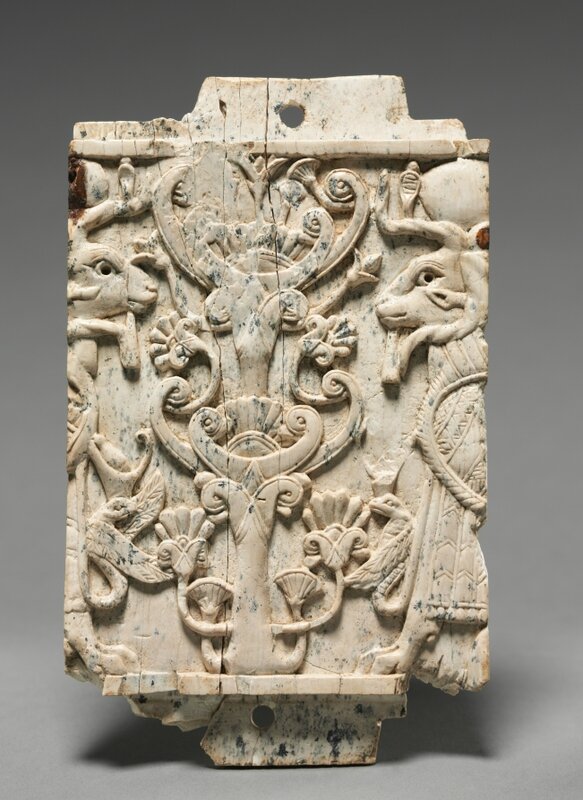Ivory Decorative Plaques, Phoenician, Iraq, Nimrud, 9th-8th Century BC at the Cleveland Museum of Art
Decorative Plaque: Man; and Griffin in Combat, Phoenician, Iraq, Nimrud, 9th-8th Century BC, ivory, Overall: 6.50 x 3.90 cm (2 1/2 x 1 1/2 inches). Purchase from the J. H. Wade Fund 1968.45. The Cleveland Museum of Art.
Decorative Plaque: Winged Sphinx, Phoenician, Iraq, Nimrud, 9th-8th Century BC, ivory, Overall: 16.10 x 5.50 x 1.10 cm (6 5/16 x 2 1/8 x 3/8 inches). Purchase from the J. H. Wade Fund 1968.46. The Cleveland Museum of Art.
Decorative Plaque: Ram-Headed Sphinxes Flanking a Sacred Tree, Phoenician, Iraq, Nimrud, 9th-8th Century BC, ivory, Overall: 15.10 x 9.00 x 1.10 cm (5 15/16 x 3 1/2 x 3/8 inches). Purchase from the J. H. Wade Fund 1968.47. The Cleveland Museum of Art.
Decorative Plaque: Cow Nursing Its Calf, Phoenician, Iraq, Nimrud, 9th-8th Century BC, ivory, Overall: 4.60 x 12.40 cm (1 3/4 x 4 7/8 inches). Purchase from the J. H. Wade Fund 1968.48. The Cleveland Museum of Art.
Decorative Plaque: Browsing Stag, Phoenician, Iraq, Nimrud, 9th-8th Century BC, ivory, Overall: 4.50 x 8.90 cm (1 3/4 x 3 1/2 inches). Purchase from the J. H. Wade Fund 1968.49. The Cleveland Museum of Art.
This small plaque was executed in the Phoenician style with symmetrical compositions, elongated figural proportions, and Egyptian subjects and motifs. Examples have been found throughout the Middle East, but thousands come from Nimrud where most were excavated in the storerooms of a military arsenal built by King Shalmaneser II (858-824 bc). When the Nimrud palace was sacked in the 7th century bc, these ivories were thrown into a well, where Sir Max Mallowan (the husband of Agatha Christie) discovered them in 1951. The monumental wall relief (1943.246) was found at the same Assyrian palace at Nimrud.

/https%3A%2F%2Fprofilepics.canalblog.com%2Fprofilepics%2F1%2F0%2F100183.jpg)
/https%3A%2F%2Fstorage.canalblog.com%2F03%2F02%2F119589%2F96711876_o.jpg)
/https%3A%2F%2Fstorage.canalblog.com%2F11%2F31%2F119589%2F94773502_o.jpg)
/https%3A%2F%2Fstorage.canalblog.com%2F20%2F83%2F119589%2F94772815_o.jpg)
/https%3A%2F%2Fstorage.canalblog.com%2F26%2F72%2F119589%2F75604929_o.jpg)
/https%3A%2F%2Fstorage.canalblog.com%2F59%2F60%2F119589%2F26458628_o.jpg)







/http%3A%2F%2Fstorage.canalblog.com%2F17%2F89%2F119589%2F126235115_o.jpg)
/http%3A%2F%2Fstorage.canalblog.com%2F43%2F44%2F119589%2F126235059_o.jpg)
/http%3A%2F%2Fstorage.canalblog.com%2F65%2F33%2F119589%2F126234986_o.jpg)
/http%3A%2F%2Fstorage.canalblog.com%2F50%2F32%2F119589%2F126224909_o.jpg)